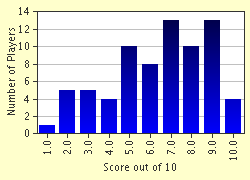Quiz Answer Key and Fun Facts
1. Assume that the partnership uses Jacoby Transfers. Here is a bidding sequence:
North-1NT, East-Pass, South-?
If South has 5 hearts, and would like to transfer to hearts, what would he bid?
2. Here is a bidding sequence:
North-1 NT, East-Pass, South-2 Clubs, West-Pass.
What should North bid, if he wants to deny a four card major? Assume that the partnership uses Stayman.
3. Here's another bidding sequence:
North-1NT, East-Pass, South-4NT, West-Pass.
South's bid of 4NT is known as what kind of bid?
4. South opens 2 diamonds. How many diamonds should he hold in his hand, if he plays with weak 2's?
5. Assume that the partnership uses the Drury convention. Here is a bidding sequence:
North-Pass, East-Pass, South-1 Spade, West-Pass, North-?.
What should North bid here if he has 3 card support and 10-11 HCP points?
6. In Standard American Yellow Card, the 1NT response bid is known as what kind of bid?
7. What does UDCA stand for?
8. Which of the following responses to a 1NT opening would be known as a "shut-out" bid?
9. Here is a bidding sequence:
North-1NT, East-Double, South-?.
Which of the following conventions could still be "on", and thus available for south to bid?
10. Here is a bidding sequence:
North-1 Diamond, East-Pass, South-Pass, West-Double, North-Pass,
East-Pass, South-Redouble.
How many of the unbid suits is South saying he can support?
Source: Author
rockinbeast2
This quiz was reviewed by FunTrivia editor
minch before going online.
Any errors found in FunTrivia content are routinely corrected through our feedback system.

